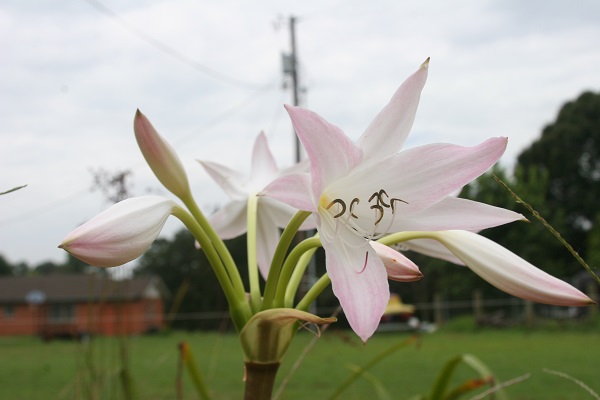


The Crinum 'Summer Nocturne' is often overlooked and doesn't get the recognition it really deserves.
Why does this cost so much less than the other crinum? The bulbs are simply smaller than other crinum bulbs, but they multiply quickly.
If they are smaller bulbs, will they be smaller plants? No, these lovely ladies will still get between 2-3 feet tall! Look at the picture below next to the bird bath.

Blooms: By late summer, most Crinum have already had their day in the sun. By mid-July, one of the only crinums we can hope to still see blooming in our gardens is the Mrs. James Hendry. Just when you think the trumpet flowers have ended for the year along comes the blooms of the Crinum 'Summer Nocturne'. She doesn't even begin to bloom until July or August! The blooms are large 3-5 inch white trumpets tipped in very pale pink. The pink darkens as the bloom ages. The blooms have a unique lightly sweet scent. Each dark green flower spike the bulb shoots up produces 6-10 blooms.

Foliage: The dark green foliage of the Crinum 'Summer Nocturne' is compact and generally tidy. This encourages you to allow the 'Summer Nocturne' to be front and center when you are searching for where to plant it.
Bulb: As we said, these bulbs are a lot smaller than our other Crinum bulbs, but they are hardy bulbs! This bulb requires little to no extra care once it is established in your garden. They are long-lived bulbs that will do well in almost any soil. If you have rock and clay soil, simply amend it and these will take care of themselves.

Planting: I would suggest planting it with the top 1/3 of the bulb above the ground. Crinum do best in full sun, but this crinum can do well with a few hours of shade each day. This crinum does well in zone 7, but be sure to mulch over the bulb during the winter.
Container: If you have a small space, this is the probably best crinum to use in a container. The small bulbs give you plenty of room for other plants and bulbs in your container. We talk about containers needing plants that are thrillers, fillers, and spillers. The Crinum 'Summer Nocturne' is your thriller. Remember that the Zephyranthes labuffarosa was a great filler, but the strappy monocot foliage of the Crinum would pair well with common annuals you could buy at any garden center this time of year.

Animals: This crinum is adored by hummingbirds and bees. Like most crinum, the deer and other animals really tend to leave it alone.
History: This crinum was developed by Thad Howard in Texas in 1964 so even though it doesn't have the long history of some of the other crinum, it definitely has the durability for southern gardens.

Planning Ahead!

The Crinum 'Summer Nocturne' is often overlooked and doesn't get the recognition it really deserves.
Why does this cost so much less than the other crinum? The bulbs are simply smaller than other crinum bulbs, but they multiply quickly.
If they are smaller bulbs, will they be smaller plants? No, these lovely ladies will still get between 2-3 feet tall! Look at the picture below next to the bird bath.

Blooms: By late summer, most Crinum have already had their day in the sun. By mid-July, one of the only crinums we can hope to still see blooming in our gardens is the Mrs. James Hendry. Just when you think the trumpet flowers have ended for the year along comes the blooms of the Crinum 'Summer Nocturne'. She doesn't even begin to bloom until July or August! The blooms are large 3-5 inch white trumpets tipped in very pale pink. The pink darkens as the bloom ages. The blooms have a unique lightly sweet scent. Each dark green flower spike the bulb shoots up produces 6-10 blooms.

Foliage: The dark green foliage of the Crinum 'Summer Nocturne' is compact and generally tidy. This encourages you to allow the 'Summer Nocturne' to be front and center when you are searching for where to plant it.
Bulb: As we said, these bulbs are a lot smaller than our other Crinum bulbs, but they are hardy bulbs! This bulb requires little to no extra care once it is established in your garden. They are long-lived bulbs that will do well in almost any soil. If you have rock and clay soil, simply amend it and these will take care of themselves.

Planting: I would suggest planting it with the top 1/3 of the bulb above the ground. Crinum do best in full sun, but this crinum can do well with a few hours of shade each day. This crinum does well in zone 7, but be sure to mulch over the bulb during the winter.
Container: If you have a small space, this is the probably best crinum to use in a container. The small bulbs give you plenty of room for other plants and bulbs in your container. We talk about containers needing plants that are thrillers, fillers, and spillers. The Crinum 'Summer Nocturne' is your thriller. Remember that the Zephyranthes labuffarosa was a great filler, but the strappy monocot foliage of the Crinum would pair well with common annuals you could buy at any garden center this time of year.

Animals: This crinum is adored by hummingbirds and bees. Like most crinum, the deer and other animals really tend to leave it alone.
History: This crinum was developed by Thad Howard in Texas in 1964 so even though it doesn't have the long history of some of the other crinum, it definitely has the durability for southern gardens.

Planning Ahead!